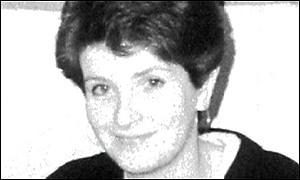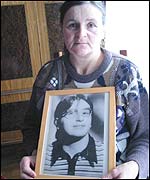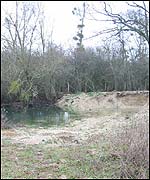
|
|
|
 |
|
Hugh Schofield in Auxerre |
|
|
|
|
|
|
|
The unsolved murder of a British student in France 12 years ago has been officially linked with the mysterious deaths or disappearances of as many as 30 young women in a tiny area of Burgundy.
|
There are some powerful people behind all this
|
|
Marie Julien
|
No-one has ever been charged with her murder, and Joanna's parents have accused the French justice system of failing to launch a proper investigation.
But now evidence has emerged suggesting that the Parrish case is part of a much wider pattern.
Cover-up suspicions
The Ministry of Justice in Paris has told the judicial inspection service to look into 17 unexplained deaths and disappearances in the Auxerre area over the last 30 years.

Marie Julies insists there was a high-level
cover-up
|
Lawyers believe the true number of missing young women may be as high as 30.
"What links all these cases are two things," said Corinne Harmann, lawyer and author of a book on the affair.
"First all the young women involved were vulnerable - either mentally slightly disabled, or like Joanna far from home.
|
We are talking about corruption
|
|
Daniel Stilinovic
|
"But more important, they were all ignored by the justice system. We do not know by whom or why, but it is clear that someone was being protected."
Indeed the suspicion is now almost inescapable of some kind of establishment cover-up.
Whoever killed Joanna may not himself have been the object of high-level protection.
But he was the unwitting benefactor of a system ordered from on high that stifled all investigations into certain types of crime.
'Disappeared of the Yonne'
The story has all the ingredients of a ghastly provincial scandal: paedophilia, torture, a serial killer, disappeared documents - all taking place within the enclosed world of a small medieval town and its decaying rural hinterland.

The care-home where Louis found his victims
|
Louis is a 68-year-old former bus driver who in the late 1970s used to ferry young disabled women to and from a care home - the Medical-Educational Institute (IME) - in Auxerre.
Between 1977 and 1979 seven young women in the care of the Auxerre social services went missing. In 1981 the body of another was found.
The investigations of a gendarme, Christian Jambert, clearly established that Louis was linked to all the women.
He was known to them all, and he could be placed by witnesses near the spots where they were last seen.
And yet inexplicably in 1984 the prosecutor's office in Auxerre refused to take the case any further.
Jambert obsessively pursued Louis for the next 13 years, convinced of his guilt.
Then in 1997, just before he was to give evidence before a new inquiry, the gendarme apparently committed suicide.
Jambert's son believes he was murdered.
Louis meanwhile was convicted of sexual abuse of other young women in his charge.
Confessions
After some years in jail, he moved to the south of France where he re-offended.

Police dug up two women's bodies after Louis
confession
|
In December 2000 he was once again questioned about the disappearances. And this time he cracked.
He confessed to seven murders and led police to a lonely spot on the banks of the River Serein at Rouvray, 15 miles northwest of Auxerre.
There in subsequent weeks they dug up two bodies of young women.
The others have never been found, but police assume they are somewhere beneath the damp clay and the undergrowth.
Louis last year retracted his confessions, hoping to avoid murder charges because of France's statute of limitations.
High-level corruption
But a decision by the Paris High Court of Appeal this week means he can now be prosecuted for two killings at least.
For the families of the "Disappeared of the Yonne," the fact that Louis was able to avoid justice for 30 years is clear evidence of high-level corruption.
"It is absolutely disgusting. The way the justice system did absolutely nothing," said Marie Julien, 49, the sister of Madeleine Dejust, whose body was one of the two found at Rouvray.
"There are some powerful people behind all this."
Her suspicions were confirmed in December when the new chief prosecutor in Auxerre made a spectacular discovery - the files on between 60 -100 criminal investigations launched between 1958 and 1982 - many of them into missing women - had disappeared.
New inquiry
It was this that prompted the justice minister Marylise Lebranchu to order an overarching inquiry into the 17 cases at Auxerre.
At the same time four senior justice officials who served in Auxerre in the 1980s are to be questioned by the Higher Council of the Magistrature (CSM).
"We are talking about corruption," said one of them, Daniel Stilinovic.
"Magistrates tampered with procedures on behalf of people they wanted to protect. It is a conspiracy at the very top."
Eerie evidence
According to Ms Harrmann, there was in small-town Auxerre a climate in which sexual depravity and criminal impunity went hand-in-hand.
Two other tales of sex abuse in Auxerre provide further eerie evidence.
In the late 1970s a man called Claude Dunand ran a kind of sadistic sex parlour in the village of Appoigny, five miles north of Auxerre.
He kidnapped and imprisoned vulnerable young girls, all with links to the social services.
He was convicted, imprisoned and recently released. Strangely his list of clients vanished during the investigation.
Even more strangely, he knew Emile Louis.
Then in 1992 a man called Philippe Charrier was convicted of abusing young women in Auxerre.
Charrier was a well-connected Auxerre notable. He also ran the care-home where Emile Louis found his victims.
For those who have followed the case of the "Disappeared of the Yonne," the series of coincidences, oversights and disappearances is too much to accept.
Something very bad was happening in Auxerre, and some very important people tried to keep it quiet.
The families of those who have gone - not least the Parrishes - are crying out for justice.